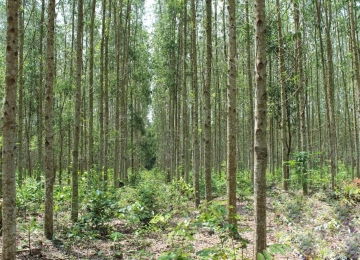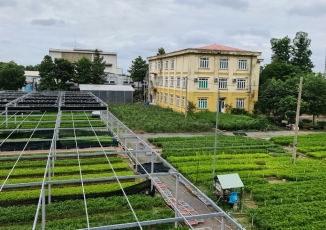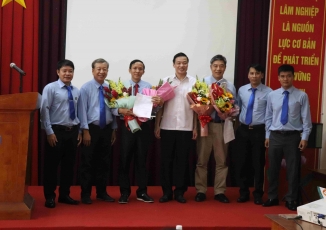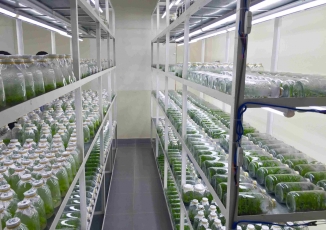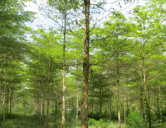Ấn phẩm khoa học
Returns to Vietnamese smallholder farmers from managing acacia plantations for sawn wood over 4-10 year rotations
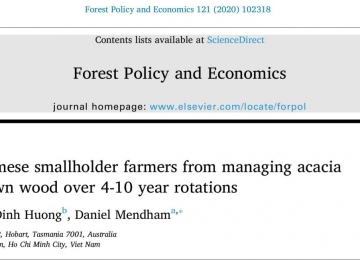
Since 1990, forest area in Vietnam has increased by around 15%, and now comprises more than 42%. The increase is mainly due to the establishment of short rotation Acacia plantations, which assist in the rehabilitation of under-utilised lands, and can be grown in short rotations by smallholder farmers for a range of uses. Presently, a high demand for woodchips encourages farmers to maintain short rotations for pulplogs and provides them with a relatively quick return from their forestry land. The Vietnamese Government has recognised an opportunity to increase sawlog production for a rapidly expanding furniture industry. The main objective of this study was to understand if small-scale Acacia plantations, managed for both pulp- and sawlog production, could provide an attractive return to smallholder farmers. Forecast earnings from the models indicated that opportunities exist for smallholders to improve their financial returns. With minimal additional inputs, plantations with a thinning intervention treatment at 3-years would be more profitable than unthinned ones, irrespective of whether the plantations were harvested in year 4 through to year 8. In 4 to 8-year rotations, the 6-year thinned operation was modelled as being the most profitable. When plantation models were extended to 10-years, the returns were even higher because of the greater volume of larger diameter higher value sawlogs. Sensitivity modelling found shorter rotation returns were highly sensitive to factors influencing income, whereas 10-year rotations were shown to be more resilient, although the growers would need to manage their risk profile, as well as acquire the knowledge and management skills required to effectively manage longer rotations. Outcomes from the study suggest that growing for sawlogs is a better option for farmers, in terms of the internal rate of return. A transition from short to longer rotations will require support for farmers, in terms of: (1) risk management, (2) training in longer rotation management, and (3) greater social acceptance of longer rotations.
Growth, physiological responses and wood production of an Acacia auriculiformis plantation in southern Vietnam following mid-rotation thinning, application of phosphorus fertiliser and organic matter retention

Acacia auriculiformis plantations are widely planted in Vietnam. Initially they were grown for wood chip production, but these plantations have potential to be managed for higher value sawing and/or peeling grade logs, through enhanced silvicultural management. This study sought to understand the impact of resource constraints on responses of A. auriculiformis plantations to thinning, phosphorus fertiliser application and slash retention at age four years on growth and physiology of A. auriculiformis trees to rotation end at age nine years. A trial in South Vietnam had a factorial combination of thinning (unthinned (planted at 1666 trees ha−1), or thinned to 833 trees ha−1), P fertilizer (Nil, or 50 kg P ha−1), and organic matter manipulation (slash and litter retained or removed).
Solid wood property variations in early-age Acacia plantation trees grown in southern Vietnam
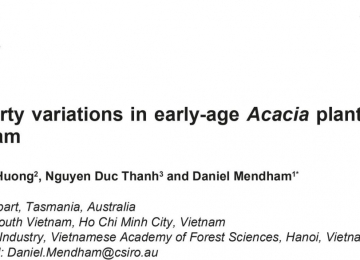
A high demand for woodchips has encouraged smallholder farmers in Vietnam to invest in short-rotation Acacia plantations to produce pulpwood that has a relatively quick, though often low, income return. Because of an expanding export furniture industry, the Vietnam Government has sought to increase sawlog production and, at the same time, improve returns to smallholder farmers. However, currently the quality and therefore market value of the timber from acacias under differing management strategies has not been well quantified. Acacia auriculiformis, both in its pure form and its hybrid with A. mangium (Acacia hybrid) are grown in plantations in Vietnam to produce merchantable timber, though the inferior mechanical properties of juvenile wood at an early age has impeded access to higher-value product markets. However, with thinning, there may be improvements in wood properties that could enhance sawlog values. This study examined how the wood properties of plantation grown Acacia hybrid change with stand age, explored differences in wood properties between Acacia hybrid and A. auriculiformis following different thinning treatments, and determined which of the two species is the most favourable for solid wood products. The potential to supply logs to produce sliced veneer for the furniture industry was also investigated. Logs from A. hybrid trees aged eight years could be processed to manufacture structural products, and at age five years for manufacturing utility furniture. Acacia auriculiformis thinned to 833 stems per hectare at age 4 years had mechanical wood properties indicating a potential for durable flooring products that can command a high value in the market. Because of dead knots, most sliced veneer samples were not acceptable for face veneer, though visual assessments indicated that with pruning, an attractive high-value product could potentially be produced. Tree species rather than age or thinning treatment had the most influence on wood properties.
Sustainable Management of Acacia auriculiformis Plantations for Wood Production over Four Successive Rotations in South Vietnam
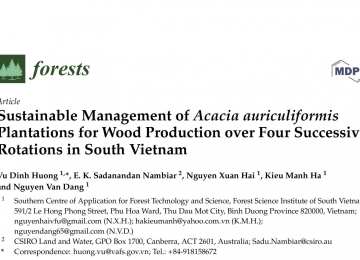
Vietnam’s forestry sector is facing rising demands for wood to support national and rural economies, and rural livelihoods. A feasible option to meet this demand is to improve productivity in the current plantation estates, especially in those owned by thousands of small growers. Growers have invested in short-rotation acacia plantations primarily for the woodchip market, but are being urged through government policies and pressured by certification bodies and some NGOs to shift to longer rotations, preferentially, for growing saw logs. In this context, we examined the productivity of an Acacia auriculiformis plantation in South Vietnam, over four successive rotations, spanning 25 years. We show that it is possible to increase and sustain wood production in the long term, by applying simple but integrated management practices, recognizing that the conservation of site resources is critical for sustainability. Practices which depleted site organic matter and nutrients lead to a hidden, but high, cumulative loss of production. Given the site and soil damaging practices prevalent in the country, it is likely that production foregone in those sites may be equivalent to the yield from one in every four or five rotations harvested. With sound management including the conservation of site resources, planting the best germplasm, appropriate stocking and judicious use of herbicide, total wood production and the proportion of saw logs (50–70% of the commercial wood at about 7 years of age) can be increased substantially. At the same time, these practices also can promote understory development and diversity in the stand. Such holistic benefits are possible without extending the rotation length and/or thinning, which are likely to raise the levels of risks for small growers, who are not covered by any insurance. Investments and support for small growers to enable higher productivity and value per unit area in their holdings, through sustainable management, would offer practical and low-risk options for the benefits of growers, processors and ecosystems
Kết quả nghiên cứu khoa học lâm nghiệp giai đoạn 2000 - 2016
VIDEO CLIPS
Liên kết
Ấn phẩm mới
Thống kê truy cập
Đang online: 7
Truy cập ngày: 13242
Tổng truy cập: 275923





